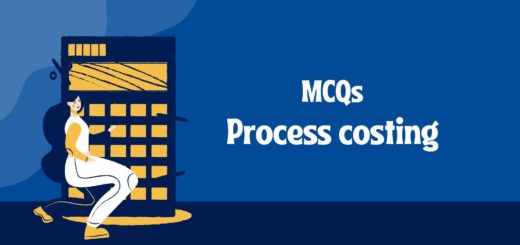MCQ’s on Amalgamation – Absorption and External Reconstruction AS-14 | (Free Resource)
21. On amalgamation, Share issue Expenses A/c appearing on Assets side of the balance sheet of the vendor company
(a) is closed by debit to Realisation A/c
(b) is closed by debit to Equity Shareholders A/c
(c) is closed by debit to Profit & Loss A/c
(d) is closed by credit to Equity Shareholders A/c
22. On amalgamation, Profit & Loss A/c (Dr.) balance of the vendor company
(a) is closed by debit to Realisation A/c
(b) is closed by debit to Equity Shareholders A/c
(c) is closed by credit to Equity Shareholders A/c
(d) is closed by credit to Realisation A/c
23. On amalgamation, Debenture A/c appearing in the balance sheet of the vendor company
(a) is closed by credit to Purchasing Company A/c, if debentures are taken over by the purchasing company
(b) is closed by credit to Realisation A/c, whether debentures are taken over by the new company or not
(c) is closed by credit to Debentureholders A/c, if debentures are not taken over by the new company
(d) is closed by debit to Realisation A/c, whether debentures are taken over by the new company or not
24. On amalgamation, Provident Fund A/c appearing on the Liabilities side in the balance sheet ofthe vendor company
(a) is closed by credit to Purchasing Company A/c
(b) is closed by credit to Realisation A/c
(c) is closed by credit to Equity Shareholders A/c
(d) is closed by debit to Realisation A/c
25. On amalgamation, Sinking Fund A/c appearing on the Liabilities side in the balance sheet of thevendor company
(a) is closed by credit to Purchasing Company A/c
(b) is closed by credit to Realisation A/c
(c) is closed by credit to Equity Shareholders A/c
(d) is closed by debit to Realisation A/c
26. On amalgamation, if the dissolution expenses are paid as well as borne by the purchasing company
(a) Entries are passed in the books of the purchasing as well as the vendor company
(b) no entry is passed in the books of the vendor company
(c) no entry is passed in the books of the purchasing company
(d) no entry is passed in the books of the purchasing as well as the vendor company
27. On amalgamation, if pref. shares are settled at a premium
(a) the premium is credited to Realisation A/c
(b) the premium is debited to Realisation A/c
(c) the premium is credited to Security Premium A/c
(d) the premium is debited to Capital Reserve A/c
28. On amalgamation, accounting procedure used by the vendor company
(a) is the same in all types of amalgamation
(b) is different depending upon whether the amalgamation is in the nature of a merger or apurchase as defined by Accounting Standard 14
(c) is different depending upon whether the companies are private or public
(d) is different depending upon the amount of purchase consideration
29. On amalgamation, accounting procedure used by the purchasing company
(a) is the same in all types of amalgamation
(b) is different depending upon whether the amalgamation is in the nature of a merger or apurchase as defined by Accounting Standard 14
(c) is different depending upon whether the companies are private or public
(d) is different depending upon the amount of purchase consideration
30. All the assets and liabilities of the vendor company become the assets and liabilities of thepurchasing company
(a) if the amalgamation is in the nature of merger as defined under AS 14
(b) if the amalgamation is in the nature of absorption as defined under the Companies Act
(c) if the amalgamation is in the nature of external reconstruction as defined under the CompaniesAct
(d) if the amalgamation is in the nature of purchase as defined under AS 14
| Answer: 21)is closed by debit to Equity Shareholders A/c 22)is closed by debit to Equity Shareholders A/c 23)is closed by credit to Realisation A/c, whether debentures are taken over by the new company or not 24)is closed by credit to Realisation A/c 25)is closed by credit to Equity Shareholders A/c 26)no entry is passed in the books of the vendor company 27)the premium is debited to Realisation A/c 28)is the same in all types of amalgamation 29)is different depending upon whether the amalgamation is in the nature of a merger or apurchase as defined by Accounting Standard 14 30)if the amalgamation is in the nature of merger as defined under AS 14 |
31. Shareholders holding not less than 90% of the face value of the equity share capital in thevendor company become equity shareholders in the purchasing company
(a) if the amalgamation is in the nature of merger as defined under AS 14
(b) if the purchase consideration is calculated under payment method
(c) if the amalgamation is in the nature of external reconstruction as defined under the CompaniesAct
(d) if the amalgamation is in the nature of purchase as defined under AS 14
32. The assets and liabilities of the vendor company are incorporated in the accounts of the purchasing company at book values
(a) if the amalgamation is in the nature of merger as defined under AS 14
(b) if the amalgamation is in the nature of purchase as defined under AS 14
(c) if the purchase consideration is calculated under Net Assets method
(d) if the amalgamation is in the nature of external reconstruction as defined under the CompaniesAct
33. In the books of the purchasing company, the assets and liabilities of the vendor company are incorporated on the basis of their agreed values (i.e. either the book values or the fair values)
(a) if the amalgamation is in the nature of merger as defined under AS 14
(b) if the amalgamation is in the nature of purchase as defined under AS 14
(c) if the purchase consideration is calculated under Net Assets method
(d) if the amalgamation is in the nature of external reconstruction as defined under the CompaniesAct
34. The difference between the purchase consideration and the net assets of the vendor company,if any, is either debited to the Goodwill Account or credited to the Capital Reserve Account
(a) if the amalgamation is in the nature of merger as defined under AS 14
(b) if the amalgamation is in the nature of purchase as defined under AS 14
(c) if the purchase consideration is calculated under Net Assets method
(d) if the amalgamation is in the nature of external reconstruction as defined under the CompaniesAct
35. Under purchase method of amalgamation, the reserves of the vendor Company
(a) are not brought in the books of the purchasing company
(b) (except a statutory reserve) are not brought in the books of the purchasing company
(c) are brought in the books of the purchasing company
(d) (except a statutory reserve) are brought in the books of the purchasing company
36. Amalgamation Adjustment Reserve
(a) should be shown as a Fixed Asset in the balance sheet of the purchasing company
(b) should be shown as a Fictitious Asset in the balance sheet of the vendor company
(c) should be shown under Reserves and Surplus in the balance sheet of the purchasing company
(d) should be shown as a Fictitious Asset in the balance sheet of the purchasing company
37. The amounts paid by the purchasing company to discharge the debentures are
(a) ignored while calculating purchase consideration by net payment method
(b) ignored while calculating purchase consideration by net asset method
(c) considered while calculating purchase consideration by net payment method
38. The amounts paid by the purchasing company to discharge the contingent liabilities are
(a) ignored while calculating purchase consideration by net payment method
(b) ignored while calculating purchase consideration by net asset method
(c) considered while calculating purchase consideration by net payment method
39. The amounts paid by the purchasing company to meet the expenses of winding up are
(a) ignored while calculating purchase consideration by net payment method
(b) ignored while calculating purchase consideration by net asset method
(c) considered while calculating purchase consideration by net payment method
40. The agreed values at which the assets or liabilities are taken over by the purchasing company are
(a) ignored while calculating purchase consideration by net payment method
(b) ignored while calculating purchase consideration by net asset method
(c) considered while calculating purchase consideration by net payment method
| Answer: 31)if the amalgamation is in the nature of purchase as defined under AS 14 32)if the amalgamation is in the nature of merger as defined under AS 14 33)if the amalgamation is in the nature of purchase as defined under AS 14 34)if the amalgamation is in the nature of purchase as defined under AS 14 35)(except a statutory reserve) are not brought in the books of the purchasing company 36)should be shown under Reserves and Surplus in the balance sheet of the purchasing company 37)ignored while calculating purchase consideration by net payment method. 38)ignored while calculating purchase consideration by net payment method 39)ignored while calculating purchase consideration by net payment method 40)ignored while calculating purchase consideration by net payment method |
41. The value of assets or liabilities not taken over by the purchasing company is
(a) ignored while calculating purchase consideration by net payment method
(b) ignored while calculating purchase consideration by net asset method
(c) considered while calculating purchase consideration by net asset method
42. The Unamortized Expenditure not written off is
(a) ignored while calculating purchase consideration by net payment method
(b) ignored while calculating purchase consideration by net asset method
(c) considered while calculating purchase consideration by net asset method
43. Liquidation expenses of Vendor Co. agreed to be paid / re-imbursed by the Purchasing Co.,should be
(a) considered while calculating purchase consideration by net payment method
(b) considered while calculating purchase consideration by net asset method
(c) ignored while calculating the purchase consideration (whether under net payments methodor net assets method).
44. As per AS-14 purchase consideration is what is payable to
(a) Shareholders
(b) Shareholders and debenture holders
(c) Shareholders and creditors
(d) None of the above
45. When amalgamation is in the nature of merger, the accounting method to be followed is :
(a) Equity method
(b) Purchase method
(c) Pooling of interests method
(d) None of the above
46. Amalgamation adjustment reserve is opened in the books of transferee company to incorporate
(a) The assets of the transferor company
(b) The liabilities of the transferor company
(c) The statutory reserves of the transferor company
(d) None of the above
47. Under the ‘Purchase method of accounting’ , the transferee company incorporates in its books:
(a) Only the assets and liabilities of the transferor company
(b) Only the assets, liabilities and statutory reserves of the transferor company
(c) Only the assets, liabilities and reserves of the transferor company.
(d) None of the above
48. Goodwill arising on amalgamation is to be
(a) Retained in the books of the transferee company.
(b) Amortised to income on a systematic basis
(c) Adjusted against reserves and profit and loss account of the transferee company immediately.
(d) None of the above
49. Under the pooling of interests method the difference between the purchase consideration and share capital of transferee company should be adjusted to :
(a) General reserve
(b) Amalgamation adjustment reserve
(c) Goodwill or capital reserve
(d) None of the above
50. At the time of amalgamation, purchase consideration does not include
(a) The sum which the transferee company will directly pay to the creditors of the transferor company.
(b) Payments made in the form of assets by the transferee company to the shareholders of the transferor company.
(c) Preference shares issued by the transferee company to the preference shareholders of the transferor company.
(d) preference shares issued by the transferee company to the equity shareholders of the transferor company
| Answer: 41)ignored while calculating purchase consideration by net asset method 42)ignored while calculating purchase consideration by net asset method 43)ignored while calculating the purchase consideration (whether under net payments method or net assets method) 44)Shareholders 45)Pooling of interests method 46)The statutory reserves of the transferor company 47)Only the assets, liabilities and statutory reserves of the transferor company 48)Amortised to income on a systematic basis 49)General reserve 50)The sum which the transferee company will directly pay to the creditors of the transferor company |
51. The asset which is not taken under the Net assets method of calculating purchase consideration is
(a) Loose Tools
(b) Bills Receivables
(c) Machinery
(d) Share issue Expenses
52. ‘Pooling of interest’ is a method of
(a) Charging Depreciation
(b) Accounting for Amalgamation
(c) Calculation of Purchase Consideration
(d) None of the above
53. In which of the following methods, the purchase consideration is calculated on the basis of the agreed value of the shares of the transferor company ?
(a) Net Asset Method
(b) Net Payment Method
(c) Intrinsic Value Method
(d) None of the above
54. The adjustment entry passed to eliminate the inter-company bills of exchange is
(a) Debit bills payable a/c credit bills receivable a/c
(b) Debit bills receivable a/c credit bills payable a/c
(c) Debit amalgamation adjustment a/c, credit statutory reserve a/c
(d) None of the above
55. Under ‘Purchase method’, any excess of the amount of purchase consideration over the net acquired assets of the transferor company should be recognised as;
(a) Capital Reserve
(b) Goodwill
(c) Profit & Loss A/c
(d) None of the above
56. If there is a provision (RDD) against the debtors, such debtors are transferred to the Realisation a/c at
(a) Net Amount i.e. Debtors less RDD
(b) Current Market Value
(c) Gross Amount of Debtors
(d) None of the above
57. Under payments method, purchase consideration for the amalgamation means
(a) Aggregate of shares and cash to shareholders
(b) Aggregate of shares, cash and payment to debenture holders
(c) Shares, cash, payment to debenture holders and expenses of realisation
(d) None of the above
58. Loss or profit on realisation a/c is transferred by the transferor company, under amalgamation to
(a) Preference shareholders a/c
(b) Equity shareholders a/c
(c) Profit & loss appropriation a/c
(d) None of the above
59. Intrinsic value of each equity share of the transferor company is Rs 250 and that of the transferee company is Rs 400. The ratio of exchange of shares on the basis of intrinsic value is
(a) 2 : 1
(b) 8 : 8
(c) 8 : 5
(d) None of the above
| Answer: 51)Share issue Expenses. 52)Accounting for Amalgamation 53)Intrinsic Value Method 54)Debit bills payable a/c credit bills receivable a/c 55)Goodwill 56)Gross Amount of Debtors 57)Aggregate of shares and cash to shareholders 58)Equity shareholders a/c 59)8 : 5 |



Helpful
Keep learning.